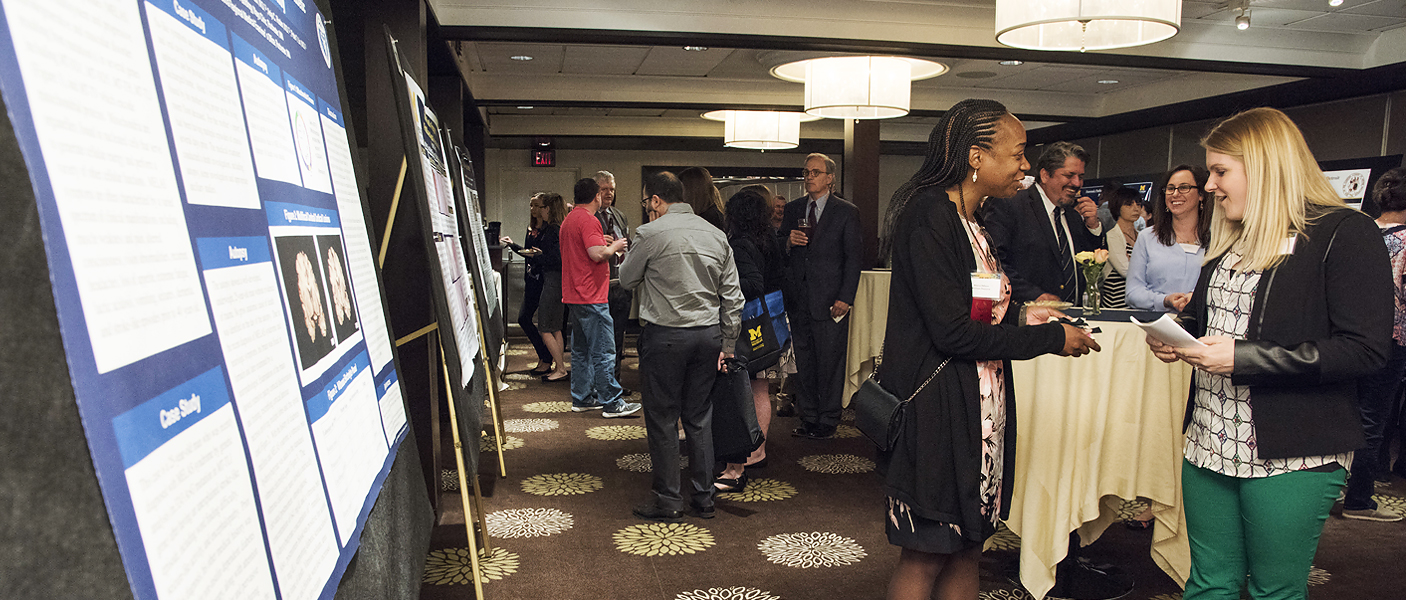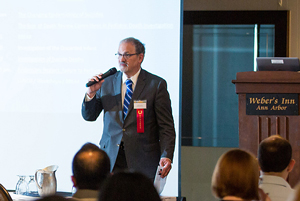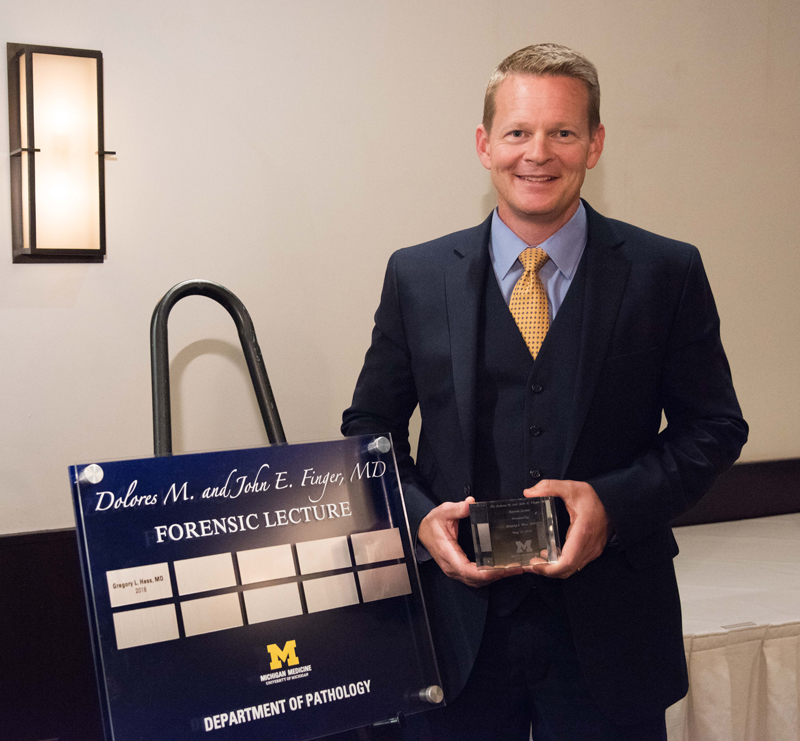


 Dr. Gregory Hess receiving the inagural Dolores M. and John E. Finger award after his keynote address.More than 100 coroners, medical examiners, death investigators, first responders and others gathered at Weber’s Inn in Ann Arbor on May 10-11 for the 9th annual Advances in Forensic Medicine and Pathology Conference hosted by the University of Michigan Medical School’s Department of Pathology. With a wide range of topics discussed, participants came from as far as India to participate in this exceptional conference. The Inaugural Dolores M. and John E. Finger, MD Forensic Lecture and dinner took place the evening of May 10th, with Dr. Gregory Hess (Chief Medical Examiner of Pima County, Tucson, AZ; Clinical Assistant Professor of Pathology, University of Arizona) being the first recipient of this award. Dr. Hess’s keynote address was “The Investigation of Undocumented Border Crossers: The Tucson Triangle”.
Dr. Gregory Hess receiving the inagural Dolores M. and John E. Finger award after his keynote address.More than 100 coroners, medical examiners, death investigators, first responders and others gathered at Weber’s Inn in Ann Arbor on May 10-11 for the 9th annual Advances in Forensic Medicine and Pathology Conference hosted by the University of Michigan Medical School’s Department of Pathology. With a wide range of topics discussed, participants came from as far as India to participate in this exceptional conference. The Inaugural Dolores M. and John E. Finger, MD Forensic Lecture and dinner took place the evening of May 10th, with Dr. Gregory Hess (Chief Medical Examiner of Pima County, Tucson, AZ; Clinical Assistant Professor of Pathology, University of Arizona) being the first recipient of this award. Dr. Hess’s keynote address was “The Investigation of Undocumented Border Crossers: The Tucson Triangle”.
Pediatric deaths represented a major theme of this year’s conference. While many understand that medical examiners and death investigators are charged with understanding when and how an individual died, their role in understanding the why is also vital, especially in the case of suicides among youth and young adults. Suicides have more than doubled in the past decade and is the 2nd leading cause of death in the 10- to 34-year-old age group, with untreated mental health conditions being a major underlying factor. Dr. Allecia Wilson (Assistant Professor, Director of Residency Training Program, Michigan Medicine) stated that among children under the age of 15, social media and electronic device usage are characteristic of suicides. The unrelenting nature of social media bullying can lead to depression. Depression added to youthful impulsivity becomes a lethal combination.
Dr. Charis Kepron (Forensic Pathologist, Eastern Ontario Regional Forensic Unit, Eastern Ontario Pathology Laboratory Association) discussed how a Pediatric Death Review Committee functions in Ottawa, Canada, with all deaths under the age of 5 and 82% of all deaths between the ages of 15-18 investigated. These reviews led to significant outcomes including expanding the metabolic screen for neonates prior to leaving the hospital, products with safety concerns reported/recalled, and changes made to molecular autopsy protocols.
Molecular protocols are playing an increasing role in forensics, especially pharmacogenomics; the study of how a person’s genetic makeup influences one’s ability to utilize pharmaceuticals. Dr. Jeffrey Jentzen (Professor and Director, Autopsy and Forensic Services, Department of Pathology, Michigan Medicine) presented data on how an individual may have mutations on the Cytochrome P450 (CYP) gene that can either reduce or enhance one’s ability to break down and utilize various drugs. By performing molecular testing, forensic pathologists are able to identify these mutations and determine that some unexpected, apparent suicides are actually accidental deaths due to the patient’s inability to break down drugs such as codeine, methadone, or even Tylenol. Family members can then be tested to avoid inadvertent overdose, receive answers as to why their family member died, and have access to life insurance benefits which may otherwise be denied.
Overdose is a growing cause of death in the United States, especially due to opioids. Dr. Hemamalini Ketha (Director of Toxicology and Drug Analysis, Department of Pathology, Michigan Medicine) reported that between 2010-2015, heroin deaths more than tripled, with 91 Americans dying daily from opioids. Fentanyl is a synthetic opioid derived from heroin and is responsible for half of all drug deaths in Wayne County, Michigan. In 2017, 10 new fentanyl analogs were identified in Michigan. These potent drugs are difficult to identify and lead to ever-increasing numbers of accidental deaths due to acute drug intoxication. Dr. Ketha reported that use of gas chromatography, TOF and Mass Spectrometry are useful in identifying these new analogs so that cause of death can be determined and emergency medical providers can properly treat patients.
In addition to the above, the Conference hosted several other topics, including multiple case reports; workshops on forensic entomology, forensic odontology, and the MDI log; how to investigate bodies found in water; medically-assisted death and an interactive “You be the Judge” session. Hosted by Judge Stephanie Domitrovich and Judge W. Milton Nuzum, III, participants decided whether or not the “expert witness” met legal criteria. As interesting and educational as these were, John Fudenberg’s (Coroner, Clark County office of the Coroner/Medical Examiner) presentation on Critical Incident Management was the highlight of Day 2.
 Coroner, John Fudenberg, spoke on the findings of the Mandalay Bay Casino shooting in 2017, as a two-part presentation.October 1, 2017, Stephen Paddock opened fire from the Mandalay Bay Casino (Las Vegas), firing more than 1,100 rounds into the Route 91 Harvest Music Festival, leaving 58 dead and 800 injured. John Fudenberg, Coroner for Clark County led the critical incident response team and walked conference attendees through the steps taken by his response team, repeatedly emphasizing the importance of conducting thorough training exercises in advance of any mass tragedy. His team had gone through such an exercise which enabled them to navigate this crisis. A critical incident plan should contain detailed plans for a call center that can handle large volumes of calls, a family assistance center (FAC) capable of months-long service, media communications, and coordination of services with external agencies. He stressed the importance of identifying and developing relationships with the FBI liaison in the area, police investigators, other coroners in the state and elsewhere who may be called upon to help. In addition, as the Coroner, he was rarely in the morgue, but rather out meeting with families, giving updates 3-4 times/day at the FAC, conducting media briefings, etc. Someone other than the Coroner or Chief Medical Examiner needs to be identified and trained in advance to run the morgue during a critical incident. John also advised the FAC be run by the emergency manager rather than the coroner’s office due to its complexity.
Coroner, John Fudenberg, spoke on the findings of the Mandalay Bay Casino shooting in 2017, as a two-part presentation.October 1, 2017, Stephen Paddock opened fire from the Mandalay Bay Casino (Las Vegas), firing more than 1,100 rounds into the Route 91 Harvest Music Festival, leaving 58 dead and 800 injured. John Fudenberg, Coroner for Clark County led the critical incident response team and walked conference attendees through the steps taken by his response team, repeatedly emphasizing the importance of conducting thorough training exercises in advance of any mass tragedy. His team had gone through such an exercise which enabled them to navigate this crisis. A critical incident plan should contain detailed plans for a call center that can handle large volumes of calls, a family assistance center (FAC) capable of months-long service, media communications, and coordination of services with external agencies. He stressed the importance of identifying and developing relationships with the FBI liaison in the area, police investigators, other coroners in the state and elsewhere who may be called upon to help. In addition, as the Coroner, he was rarely in the morgue, but rather out meeting with families, giving updates 3-4 times/day at the FAC, conducting media briefings, etc. Someone other than the Coroner or Chief Medical Examiner needs to be identified and trained in advance to run the morgue during a critical incident. John also advised the FAC be run by the emergency manager rather than the coroner’s office due to its complexity.
In times of crisis, the coroner’s office is on the front lines. Administrative and professional staff alike are faced with overwhelming pain in dealing with friends and family of those who have been lost. In the Las Vegas tragedy, John learned the importance of providing support services to help staff deal with tragedy so they are able to effectively perform their duties and support the friends and family of the deceased. Since implementing mental health programs at the Clark County Office of the Coroner/Medical Examiner, he has found ongoing benefit for himself and the staff as they deal with even the routine day-to-day challenges of their jobs.
As the 9th Annual Advances in Forensic Medicine and Pathology Conference clearly presented, forensic medicine is much more than performing autopsies to determine the time, mode and cause of death. The role of forensic medicine and pathology extends to bringing to light underlying causes of death that can be addressed, whether that be poor product design, a family’s gene mutations, social influencers, or the chemical make-up of new drugs, all while providing support for the friends and family of the deceased.
Dr. Allecia Wilson opens the conference with the topic The Changing Epidemiology of Suicide.
Visiting speaker Dr. Charis Kepron speaking about The Role of Death Review Committees in Pediatric Death Investigation.
Visiting speaker Dr. Christopher Milroy speaking on the topic Investigation of the Discarded Infant.
One of Michigan Medicine's Forensic Fellows, Adam Covach, MD, speaking on the subject Investigation of Suicide Deaths.
Presenters Carl Schmidt, MD & Judge Stephanie Domitrovich, PhD speaking on the subject Evidentiary Neglect: Failure to Perform an Autopsy.
Visiting speaker Jennifer Pechal, PhD, returning from Michigan State University to speak more on Forensic Entomology in one of Thursday's Workshop.
Attendees volunteering in an exercise from Gary Berman, DDS, DABFO, a consultant forensic odontologist from the Wayne & Washtenaw County Medical Examiner's Offices.
Visiting speaker, Gary Berman was detailed in his exercise during another of Thursday's workshops.
Resident, Krista Chain sharing her findings featured in her abstract poster on The curious case of a bloodless aortic rupture: sudden death due to aortic rupture into the lung during this year's poster session.
Resident, Ania Owczarczyk sharing information on her finds on Sudden Maternal Death: Amniotic Fluid Embolism Syndrome to Residency Training Program Director, Allecia Wilson, MD (left) and Communication's Lynn McCain (right).
Forensic Pathology Fellow, Sarah Avedschmidt, MD, discussing her finding on Acetyl Fentanyl: Trends and Concentrations in Metro Detroit with other attendees.
Conference organizer and Director of Michigan Medicine's Autopsy and Forensic Pathology, Jeffrey Jentzen, MD, PhD (left), examining a poster with an attendee and visiting speaker Barry Logan, PhD, F-ABFT (right).
Attendees Avneesh Gupta, MD (left), speaking with Dr. Leonardo Roquero during the poster session.
Judge Stephanie Domitrovich, PhD, with one of our staff organizers, Mary Currie.
Michigan Medicine Faculty, Hemamalini Ketha, PhD, spoke on the subject Forensic Toxicology-Evolution of Designer Drugs and its Implications during Friday's sessions.
During Friday's session, Forensic Fellow Sarah Avedschmidt, MD, is one of two to receive an award for their poster from program director, Allecia Wilson, MD after giving her case study.
Resident, Ania Owczarczyk, being the second to receive an award for her poster.
Dr. John H. Finger, son of John E. Finger, giving his remarks before the keynote address is given by Dr. Gregory Hess.
Dr. Jeffrey Jentzen opening Thursday night's keynote address by Dr. Gregory Hess.
Dr. Gregory Hess speaking during his keynote address, The Investigation of Undocumented Border Crossers: The Tucson Triangle.
Group shot (left to right) of department chair, Charles A. Parkos, MD, PhD, with Drs. Gregory Hess, John H. Finger, and Jeffrey Jentzen.
 ON THE COVER
ON THE COVER
Breast team reviewing a patient's slide. (From left to right) Ghassan Allo, Fellow; Laura Walters, Clinical Lecturer; Celina Kleer, Professor. See Article 2014Department Chair |

newsletter
INSIDE PATHOLOGYAbout Our NewsletterInside Pathology is an newsletter published by the Chairman's Office to bring news and updates from inside the department's research and to become familiar with those leading it. It is our hope that those who read it will enjoy hearing about those new and familiar, and perhaps help in furthering our research. CONTENTS
|
 ON THE COVER
ON THE COVER
Autopsy Technician draws blood while working in the Wayne County morgue. See Article 2016Department Chair |

newsletter
INSIDE PATHOLOGYAbout Our NewsletterInside Pathology is an newsletter published by the Chairman's Office to bring news and updates from inside the department's research and to become familiar with those leading it. It is our hope that those who read it will enjoy hearing about those new and familiar, and perhaps help in furthering our research. CONTENTS
|
 ON THE COVER
ON THE COVER
Dr. Sriram Venneti, MD, PhD and Postdoctoral Fellow, Chan Chung, PhD investigate pediatric brain cancer. See Article 2017Department Chair |

newsletter
INSIDE PATHOLOGYAbout Our NewsletterInside Pathology is an newsletter published by the Chairman's Office to bring news and updates from inside the department's research and to become familiar with those leading it. It is our hope that those who read it will enjoy hearing about those new and familiar, and perhaps help in furthering our research. CONTENTS
|
 ON THE COVER
ON THE COVER
Director of the Neuropathology Fellowship, Dr. Sandra Camelo-Piragua serves on the Patient and Family Advisory Council. 2018Department Chair |

newsletter
INSIDE PATHOLOGYAbout Our NewsletterInside Pathology is an newsletter published by the Chairman's Office to bring news and updates from inside the department's research and to become familiar with those leading it. It is our hope that those who read it will enjoy hearing about those new and familiar, and perhaps help in furthering our research. CONTENTS
|
 ON THE COVER
ON THE COVER
Residents Ashley Bradt (left) and William Perry work at a multi-headed scope in our new facility. 2019Department Chair |

newsletter
INSIDE PATHOLOGYAbout Our NewsletterInside Pathology is an newsletter published by the Chairman's Office to bring news and updates from inside the department's research and to become familiar with those leading it. It is our hope that those who read it will enjoy hearing about those new and familiar, and perhaps help in furthering our research. CONTENTS
|
 ON THE COVER
ON THE COVER
Dr. Kristine Konopka (right) instructing residents while using a multi-headed microscope. 2020Department Chair |

newsletter
INSIDE PATHOLOGYAbout Our NewsletterInside Pathology is an newsletter published by the Chairman's Office to bring news and updates from inside the department's research and to become familiar with those leading it. It is our hope that those who read it will enjoy hearing about those new and familiar, and perhaps help in furthering our research. CONTENTS
|
 ON THE COVER
ON THE COVER
Patient specimens poised for COVID-19 PCR testing. 2021Department Chair |

newsletter
INSIDE PATHOLOGYAbout Our NewsletterInside Pathology is an newsletter published by the Chairman's Office to bring news and updates from inside the department's research and to become familiar with those leading it. It is our hope that those who read it will enjoy hearing about those new and familiar, and perhaps help in furthering our research. CONTENTS
|
 ON THE COVER
ON THE COVER
Dr. Pantanowitz demonstrates using machine learning in analyzing slides. 2022Department Chair |

newsletter
INSIDE PATHOLOGYAbout Our NewsletterInside Pathology is an newsletter published by the Chairman's Office to bring news and updates from inside the department's research and to become familiar with those leading it. It is our hope that those who read it will enjoy hearing about those new and familiar, and perhaps help in furthering our research. CONTENTS
|
 ON THE COVER
ON THE COVER
(Left to Right) Drs. Angela Wu, Laura Lamps, and Maria Westerhoff. 2023Department Chair |

newsletter
INSIDE PATHOLOGYAbout Our NewsletterInside Pathology is an newsletter published by the Chairman's Office to bring news and updates from inside the department's research and to become familiar with those leading it. It is our hope that those who read it will enjoy hearing about those new and familiar, and perhaps help in furthering our research. CONTENTS
|
 ON THE COVER
ON THE COVER
Illustration representing the various machines and processing used within our labs. 2024Department Chair |

newsletter
INSIDE PATHOLOGYAbout Our NewsletterInside Pathology is an newsletter published by the Chairman's Office to bring news and updates from inside the department's research and to become familiar with those leading it. It is our hope that those who read it will enjoy hearing about those new and familiar, and perhaps help in furthering our research. CONTENTS
|

MLabs, established in 1985, functions as a portal to provide pathologists, hospitals. and other reference laboratories access to the faculty, staff and laboratories of the University of Michigan Health System’s Department of Pathology. MLabs is a recognized leader for advanced molecular diagnostic testing, helpful consultants and exceptional customer service.